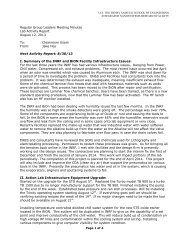Download Lab Safety Manual - Integrated Nanosystems Research ...
Download Lab Safety Manual - Integrated Nanosystems Research ...
Download Lab Safety Manual - Integrated Nanosystems Research ...
You also want an ePaper? Increase the reach of your titles
YUMPU automatically turns print PDFs into web optimized ePapers that Google loves.
Pour the used chemical into the labeled waste container:<br />
‣ This should be done at the wet bench, using a chemically compatible funnel for safe pouring. Rinse the<br />
container you used for processing with water three times, pouring the rinse water each time into the waste<br />
container. Pour the water used to rinse the substrates into the waste container.<br />
Cap the container:<br />
‣ Make sure that the outside of the container is clean and dry. Make sure that cap is a vented cap, and the<br />
hazardous waste label is securely attached.<br />
Transport the container using the transfer cart:<br />
‣ Place the container on the appropriate hazardous waste transport cart, using a polypropylene cart for acid and<br />
a metal cart for solvent transport to waste to the disposal room W2312.<br />
What is solid hazardous waste?<br />
12.3 Solid Hazardous Waste Disposal<br />
Chemically contaminated objects are considered solid hazardous waste. These include gloves, lab wipes, swabs,<br />
plastic syringes and syringe filters. These must not be disposed of in the regular garbage cans because of the outgas<br />
vapors and they may harm the lab staff. Chemically contaminated solid waste should be categorized by<br />
chemical class:<br />
‣ Flammable (solvents, photoresists, etc.)<br />
‣ Corrosive and other waste (acids and bases, other chemicals)<br />
“Sharps” are objects that can cut or puncture skin. These include silicon or silicon germanium wafers (not GaAs,<br />
which must be disposed as chemically hazardous waste), broken glass beakers, razor blades/exacto<br />
knives/scalpels, or hypodermic needles. Out of concern for safety, sharps must not be thrown into the regular<br />
garbage cans.<br />
How to dispose of solid solvent/resist/flammable waste:<br />
‣ Work under an exhausted area, to avoid inhaling chemical fumes.<br />
‣ Place the waste into a plastic bag (Ziploc bags are available throughout the lab).<br />
‣ Secure the bag, so that it is air-tight<br />
‣ Place the waste in one of the designated Solid Flammable waste containers.<br />
If you are working with chlorinated solvent waste, follow the procedures for “corrosive and other waste” below.<br />
Do not place chlorinated solvent waste into the Solid<br />
35



